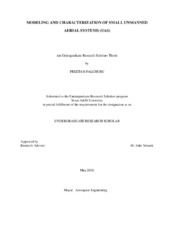| dc.description.abstract | The objective of this research aims to develop efficient methods to verify and validate linear
time-invariant models derived from nonlinear time-variant systems. The parametric model will be
compared to a non-parametric model of a small UAS (obtained from flight test data) to test for
accuracy. If the parametric model is not as accurate as the non-parametric flight test model, then
the parametric model will be tweaked to match the non-parametric model as closely as possible.
A proper understanding of aircraft dynamical modeling is necessary to ensure proper adjustment
of the model. In order for the parametric model to be accurate, the model must undergo validation
and verification. The physics of the plane should be validated. In other words, does the plane
adhere to physical laws in flight? Once the model is validated, it must be verified. In order to deal
with the nonlinearity of the problem, genetic algorithms will be used to match the eigenvalues of
the parametric and non-parametric models as closely as possible. | en |


